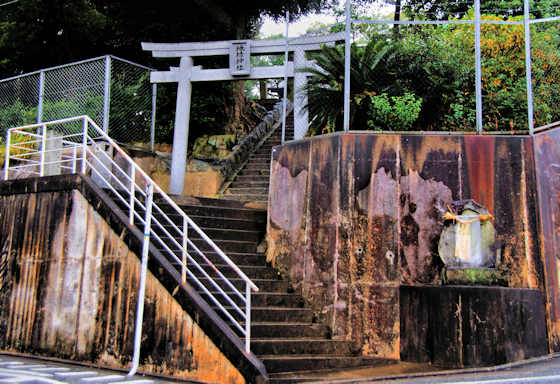Saturday, February 8, 2014
Izumo 33 Kannon Pilgrimage Temple 10 Zenjoji
Thursday, February 6, 2014
Chiroku Shrine
Chiroku Shrine
Labels:
haniyasuhime,
izanagi,
komainu,
kyushu108,
Shrine,
takehaniyasuhiko
Tuesday, February 4, 2014
Mitoya Tenmangu
Sunday, February 2, 2014
Shokasonjuku Academy
The Shokasonjuku is located in the grounds of the Shoin Shrine in Hagi, Yamaguchi, and is where Yoshida Shoin taught many of the future leaders of Meiji Japan.
It was originally just a single-roomed structure but was expanded due to the large number of students who wanted to attend. It was also his home as at the time he was under house arrest for his attempt to stow away on an American ship.
Shoin taught here for just one year before he was rearrested and the school forced to close.
His students included Ito Hirobumi, the first Prime Minister of Japan, Yamagata Aritomo, Japan's third Prime Minister, Kido Takayoshi, a senior statesman and another of the architects of the new Meiji state, Inoue Kaoru, another major politician and statesman of Meiji Japan.
Labels:
hagi,
yamaguchi,
yoshida shoin
Thursday, January 30, 2014
Izumo 33 Kannon Pilgrimage Temple 9 Mine-ji
I have been to Mineji before and found it to be really interesting. Details about the temple and its history can be found in this post, and a post about the Nio and Fudo Myoo can be found here. One thing that was new this time was that the roof of the Niomon was covered in solar panels.
Though I already had plenty of photos it was a different day with different lighting conditions and I had a different camera, so I wandered around taking more photos.
Its only 180 meters above sea level, but still has nice views down to the valley and town below.
I hadn't noticed the garden before...... I went to the little office to chat with the priests, a father and son, and learnt that there was something else new.... a small tsuyado, a room offered for free for pilgrims to stay in. The son had walked the Shikoku pilgrimage and had obviously stayed in the many tsuyados there. This is the only one I know about on the Izumo 33 pilgrimage. They offered me the use of it for the night, and though there were still several more hours of daylight and my plan had been to sleep out a bit further upriver, I accepted.
The next morning as I was leaving the son came up and gave me some onigiri and fruit to have for breakfast. I like Mine-ji :)
Monday, January 27, 2014
Manhole Horses
There is archeological evidence that horses have been in Japan for thousands of years, however the earliest records of Japan by the Chinese in the third century say that Japan did not have any horses. It is known that horses were introduced from Korea in the 4-5th centuries and this seems to be from when most Japanese horses are descended. The above manhole is from Mochizuki, a small town in Nagano. The area bred and raised horses for the Imperial court since ancient times.
Kushima, at the southern tip of Miyazaki, is home to a breed of wild pony, the Misaki Pony, considered a Japanese breed. They live on Cape Toi and are a tourist attraction. there are about 100 of them. Misaki means "cape".
This final one is from Ishigaki Island in Okinawa, and other than the fact that the area offers horse riding as an attraction I can find no explanation for the horse on their manhole design.
Saturday, January 25, 2014
Izumo 33 Kannon Pilgrimage Temple 8 Hasedera
Thursday, January 23, 2014
Hiroshima Museum of Contemporary Art
The Hiroshima Museum of Contemporary Art was opened in 1989 on top of Hijiyama overlooking the city.
The most noticeable feature is the circular structure at the main entrance.
The gap in the circle is oriented towards the location of the nuclear bomb epicenter.
It was designed by Kisho Kurokawa who designed many museums in Japan and is considered one of the founders of the Metabolism Movement, a contemporary style of Japanese architecture.
It is a very large structure, but most of it is below ground.
The style of the buildings reflects that of traditional Japanese storehouses.
Labels:
Architecture,
hiroshima,
kisho kurokawa,
Museum
Monday, January 20, 2014
Mishiro Shrine
Mishiro Jinja
Labels:
aohatasakusahiko,
engi shiki,
inari,
Izumo Fudoki,
izumo33,
komainu,
Kushinada,
otoshi,
oyamakui,
Shrine,
Susano
Friday, January 17, 2014
Shikoku 88 Pilgrimage Temple 23 Yakuoji
With its distinctive hillside pagoda visible from miles away when approaching Hiwasa, Yakuoji is the last of the pilgrimage temples in Tokushima before entering Kochi.
According to the legend it was founded by Gyogi, and Kukai later visited and carved the statue of Yakushi Nyorai. It is a Shingon temple.
Apart from its place in the Shikoku 88 temple pilgrimage, it also receives hundreds of thousands of visitors from all over Japan who come here to pray for protection for their "unlucky" years, ages 41, 42, & 61 for men, and 32, 33, and 61 for women.
The approach to the temple has two sets of steps, the one for men has 42 steps, and the one for women has 33 steps. The steps up to the pagoda has 61 steps. A coin is left on each step as one climbs.
There are some fine views over the coastal town with its small, reconstructed castle....
Subscribe to:
Posts (Atom)










































